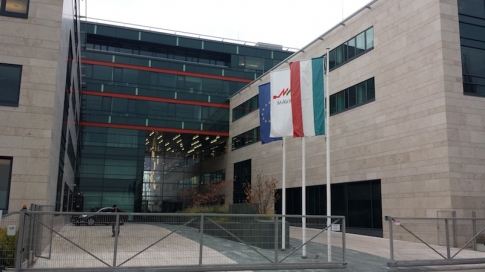News
2014-11-06
Meeting with MAVIR in Budapest
We met MAVIR, the Hungarian Transport System Operator (TSO) on November 6th in Budapest. This visit occurred in the framework of our networking mission throughout Europe.


MAVIR and LIFE Elia presentation
MAVIR, the only TSO in Hungary is owned by the Hungarian state. The company is relying on 3.800 km of high tension lines supported by around 11.000 pylons. Divided in 5 districts, the Hungarian grid crosses wooded areas on approximately 1.700 ha. Corridors are measuring between 25 and 60 m wide, and tension of the lines are in majority 220 and 400 kV, but also 120 and 750 kV.
Vegetation management on these forests corridors consists in mulching with tractors or cutting trees manually when needed (steep sections or rocky areas). Depending on vegetation dynamics, this operation is repeated every 2 to 5 years. MAVIR has insourced this task and has chosen this technique mainly because of its simplicity of management, the reduced costs and the limited time needed to operate on site. MAVIR concludes that this way of managing the vegetation is also offering a high electrical safety.
However, 4 experimental studies have been led in Hungary to assess whether alternative techniques could be more interesting for the company. The purpose of the field trip was to visit these experiments on site.


The MAVIR team appreciated the LIFE Elia presentation, both for its interest on maintenance issues and on communication perspectives. MAVIR would be interested to know more about the results of the ongoing cost/benefits analysis. Indeed, the Hungarian energy regulation commission imposes a drastic cost reduction that implies close attention from the company regarding eventual additional costs.
Field trip in Szendehely and in Vác : using local bush vegetation and building man made nest for birds
The first part of the visit consisted in showing the experiment led on vegetation management. A private forest company, which was subcontracted during 5 years, cut by selecting trees species with a high final height and on the other hand cautiously kept on site bushy species.

Annual cuttings stopped in 2011 and the result on the field is dense shrub and bushes vegetation just under overhead lines. Since then no cutting operations were required for electrical safety, showing the impact of the new dominating vegetation. Indeed, the leaves density of the bushes does not allow any tree species to germinate and grow. The place of the test was selected because there was no Acacia (Robinia pseudoacacia), , which is particularly invasive in Hungary, and because shrub species were already present on-site. The technique is called "near-nature" vegetation management.
Calculations made by MAVIR team resulted in an investment return period of 15 years. This type of vegetation management is very close to our forest edges restoration done in Belgium.





The second part, near Vác, of the visit consisted in observing a man-made nest for Saker falcon (Falco cherrug). This bird friendly work guarantees a better cohabitation between the electrical grid and biodiversity : birds find a stable place to nest and the TSO avoid any nest falling on isolators or conductors. This is the fruit of a successful collaboration between MAVIR and the national Bird protection Federation.



